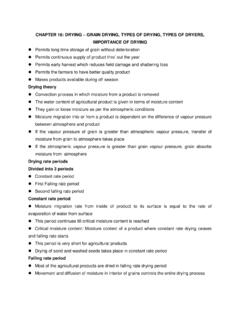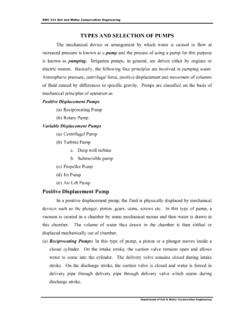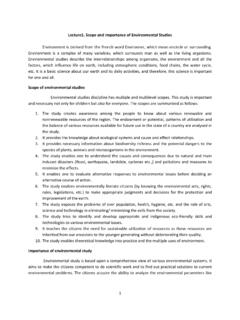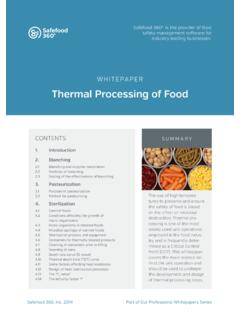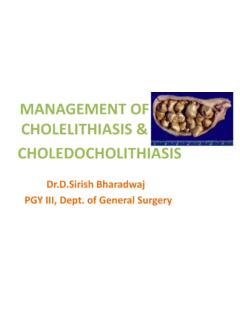Transcription of PRINCIPLES OF PRESERVATION
1 PRINCIPLES OF PRESERVATION PRINCIPLES of Food PRESERVATION A good method of food PRESERVATION is one that slows down or prevents altogether the action of the agents of spoilage. Also, during the process of food PRESERVATION , the food should not be damaged. In order to achieve this, certain basic methods were applied on different types of foods. For example in earlier days, in very cold weather condition, ice was used to preserve foods. Thus, very low temperature became an efficient method for preventing food spoilage. Let us now list the PRINCIPLES of food PRESERVATION . 1. Removal of micro-organisms or inactivating them: This is done by removing air, water (moisture), lowering or increasing temperature, increasing the concentration of salt or sugar or acid in foods. If you want to preserve green leafy vegetables, you have to remove the water from the leaves so that micro organisms cannot survive.
2 You do this by drying the green leaves till all the moisture evaporates. 2. Inactivating enzymes: Enzymes found in foods can be inactivated by changing their conditions such as temperature and moisture, when you preserve peas, one of the methods of preservations is to put them for a few minutes in boiling water. This method also known as blanching inactivates enzymes and thus, helps in preserving the food. 3. Removal of insects, worms and rats: By storing foods in dry, air tight containers the insects, worms or rats are prevented from destroying it. Control Control of microorganisms Heat Cold Drying Acids Sugar and salt Oxygen concentration Smoke Radiation Chemicals (preservatives) Control of enzymes Heat Oxygen removal Acids Chemicals (antioxidants) Control of Other factors Protective packaging Sanitation PRESERVATION methods 1. Thermal processing Application of heat Inactivate enzymes Kill microorganisms.
3 Most bacteria are killed in the range 82-93 c. Spores are not destroyed even by boiling water at 100 c for 30 min. o To ensure sterility (total microbial destruction, including spores), a temperature of 121 c must be maintained for 15 min or longer. Various methods are - a. Blanching b. Pasteurization c. Sterilization d. Boiling e. Steam under pressure 2. Removal of heat (cold processing) Lowering temperature of food Decreases the rate of enzymatic, chemical and microbial reactions in food Storage life is extended Various methods are - a. Refrigeration b. Freezing 3. Control of water content (drying) Microorganisms require free water Free water is removed from the food and therefore, is unavailable to microbial cells Multiplication will stop Water unavailable for chemical/biochemical reactions Storage life extended Various methods are - a. Freezing b.
4 Physical removal of water from food (dehydration) c. Removal of some of the water from food (concentration) d. Addition of substances that bind water in food, making it unavailable (sugar, salts) 4. Radiation Ionizing radiation Inactivate microorganisms in food Destroy storage pests Inactivate enzymes Various methods are - a. Infrared radiation b. Ultraviolet radiation 5. Atmosphere composition Removal of oxygen Inhibits o2-dependant enzymatic and chemical reactions Inhibits growth of aerobic microorganisms Various methods are - a. Paraffin wax b. Nitrogen backflushed bags (potato chips) c. Controlled atmosphere storage d. Vacuum packaging of fresh food (cured meats) 6. Fermentation Specific microorganisms are used (starter cultures) Facilitate desirable chemical changes Longer storage life Produce acids, alcohol that will prevent growth of undesirable microorganisms Produce antimicrobial substances 2.
5 Addition of chemicals Various chemicals used are - a. Acids (inhibit microbial growth and enzymatic reactions) b. Organic acids (acetic, citric, tartaric acids) c. Inorganic acids (hydrochloric, phosphoric acids) d. Food grade, comply w/regulations e. Antioxidants (to delay oxidative rancidity) f. Antimicrobial agents: o sodium propionate (mould inhibitor) o sodium benzoate (antibacterial) o sugar and salt (high concentrations) 8. Smoke Contains preservative chemicals (eg. formaldehyde) from the burning wood Heat also helps destroy microorganisms Heat dries the food 9. Curing (Salt and Sugar) Salt binds with water molecules and thus acts as a dehydrating agent in foods. Impair the conditions under which pathogens cannot survive. Curing is used with certain fruits and vegetables. ( sauerkraut, pickles), Meats can be submerged in a salt solution known as brine PRESERVATION BY USING CHEMICALS A preservative is defined as only substance which is capable of inhibiting, retarding or arresting the growth of microorganisms.
6 Microbial spoilage of food products is also controlled by using chemical preservatives. The inhibitory action of preservatives is due to their interfering with the mechanism of cell division, permeability of cell membrane and activity of enzymes. Pasteurized squashes, cordials and crushes have a cooked flavour. After the container is opened, they ferment and spoil within a short period, particularly in a tropical climate. To avoid this, it is necessary to use chemical preservatives. Chemically preserved squashes and crushes can be kept for a fairly long time even after opening the seal of the bottle. It is however, essential that the use of chemicals is properly controlled, as their indiscriminate use is likely to be harmful. The preservative used should not be injurious to health and should be non-irritant. It should be easy to detect and estimate.
7 Two important chemical preservatives are permitted to beverages according to the FPO (1955). 1. Sulphur dioxide and 2. Benzoic acid SULPHUR DIOXIDE It is widely used throughout the world in the PRESERVATION of juice, pulp, nectar, squash, crush, cordial and other products. It has good preserving action against bacteria and moulds and inhibits enzymes, etc. In addition, it acts as an antioxidant and bleaching agent. These properties help in the retention of ascorbic acid , carotene and other oxidizable compounds. It also retards the development of nonenzymatic browning or discolouration of the product. It is generally used in the form of its salts such as sulphite, bisulphate and metabisulphite. Potassium metabisulphite (K2O 2So2 (or) K2S2O5) is commonly used as a stable source of So2. Being a solid, it is easier to use than liquid (or) gaseous is fairly stable in neutral (or) alkaline media but decomposed by weak acids like carbonic, citric, tartaric acid and malic acids.
8 When added to fruit juice (or) squash it reacts with the acid in the juice forming the potassium salt and So2, which is liberated and forms sulphurous acid with the water of the juice. The reactions involved are as follows Potassium Potassium Sulphur Meta bisulphate + Citric acid Citrate + dioxide + H2O SO2 + H2O H2SO3 (Sulphurous acid ) SO2 has a better preservative action than sodium benzoate against bacteria and moulds. It also retards the development of yeasts in juice, but cannot arrest their multiplication, once their number has reached a high value. It is well known that fruit juices with high acidity do not undergo fermentation readily. The preservative action of the fruit acid its due to is hydrogen ion concentration. The pH for the growth of moulds ranges from to , that of yeasts from , and of bacteria from to fruit beverage like citrus squashes and cordials have generally a pH of to , the growth of moulds and yeasts in them cannot be prevented by acidity alone.
9 Bacteria, however, cannot grow. The pH is therefore, of great importance in the PRESERVATION of food product and by regulating it, one or more kinds of microorganisms in the beverage can be eliminated. The concentration of So2 required preventing the growth of mirgroorganism at different pH levels are as under. pH (yeasts) Mucor (mold) Penicillium (mold) Mixed bacteria 200 200 300 100 800 600 600 300 Above 5000 Above 5000 Above 5000 Above 1000 The toxicity of So2 increases at high temperature. Hence its effectiveness depends on the acidity, pH, temperature and substances present in fruit juice. According to FPO, the maximum amount of So2 allowed in fruit juice is 700 ppm, in squash, crush and cordial 350 ppm and in RTS and nectar 100 ppm. The advantages of using So2 are a) It has a better preserving action than sodium benzoate against bacterial fermentation b) it helps to retain the colour of the beverage for a longer time than sodium benzoate ( c) being a gas, it helps in preserving the surface layer of juices also (d) being highly soluble in juices and squashes, it ensures better mixing and hence their PRESERVATION and (e) any excess of So2 present can be removed either by heating the juice to about 71oC or by passing air through it or by subjecting the juice to vacuum.
10 This causes some loss of the flavouring materials due to volatilization, which can be compensated by adding flavours. Disadvantages (or) limitations a. It cannot be used in the case of some naturally coloured juices like those of jamun, pomegranate, strawberry, coloured grapes, plum etc. on account of its bleaching action. b. It cannot also be used for juices which are to be packed in tin containers because it not only corrodes the tin causing pinholes, but also forms H2S which has a disagreeable smell and reacts with the iron of the tin container to form a black compound, both of which are highly undesirable and c. So2 gives a slight taste and colour to freshly prepared beverages but these are not serious defects if the beverage is diluted before drinking. II. Benzoic acid It is only partially soluble in H2O hence its salt, sodium benzoate is used.



